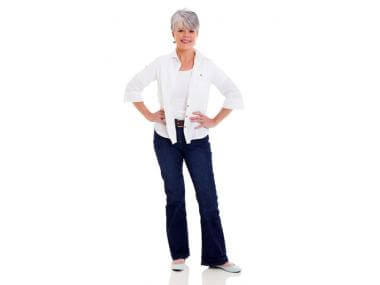Proof That Healthy Habits Turn Back the Biological Clock
We all hope that eating better and getting some exercise will keep us healthier for longer, but now a new study shows exactly how much good habits can slow the biological aging process.
Some of the benefits of eating healthy and exercising are apparent right away. In a matter of a few weeks, we can see and feel the changes in our bodies. We might see a difference on the scale, or in how our clothes fit. Or we may notice that we are less winded after going up steps or shlepping a big load of groceries. We may even perceive positive changes in our mood and energy levels.
And, of course, we also hope that these good habits are going to deliver long-term benefits as well, delaying or preventing the onset of disease or disability as we age. Those benefits can be a bit harder to measure, however.
But as scientists learn more about the aging process, they’ve developed new ways to measure and quantify “biological age” as opposed to “chronological” or “calendar” age. These markers can be used to assess the effects of various anti-aging interventions.
Measuring biological age
One of the ways scientists measure biological age is a blood test that measures the Epigenetic Mutation Load, or EML.
Although the genes that you’re born with affect your risk of certain diseases, your environment and lifestyle play a big role in how those genes express themselves over the course of your lifetime, or whether or not certain genes are switched on or off. These epigenetic changes are triggered by environmental factors like smoking, air pollution, chemical exposures, diet, stress, and so on. In other words, even if you have inherited a genetic predisposition, there is still a lot you can do to mitigate your risk through the choices you make.
The EML test looks for specific epigenetic changes that are associated with aging or disease. A higher EML score has been correlated to your likelihood of dying of cancer, for example.
Another way to assess biological age is to measure DNA methylation, a chemical process that takes place inside the body, which can alter the behavior of genes. These types of tests are often referred to as “DNAm clocks,” and they are getting better and better at predicting how long people will live and how healthy they will stay.
For example, the more advanced DNAm clocks can reliably predict your future risk of Type 2 Diabetes, heart disease, COPD, cancer, and how long you are likely to live. They’ve also been associated with other aspects of healthy aging, such as walking speed, brain health, and age-related frailty.
How to add 3 extra years of healthy life
Researchers in Italy recently used both of these tests to measure the effects of different lifestyle interventions in a group of 200+ post-menopausal women.
One of the nice things about this study is that it looked at changes in subjects’ epigenetic clocks over time, compared with a control group that did not make any changes. So, instead of a cross-sectional study, which would compare different people to one another at a single moment in time, this sort of longitudinal study allowed the researchers to measure the impact of lifestyle changes on the same people over time. It’s also worth noting that the subjects’ weight remained fairly consistent over the 2-year study, which helps to distinguish the effects of healthy lifestyle changes from the effects of weight loss.
The results suggest that the combination of a healthy diet and regular exercise could add up to 3 extra years of healthy life expectancy. However, while exercise and a healthy diet each served to turn back the biological clock, they seemed to work through different (and, hopefully, complementary) pathways.
Diet and exercise affect aging differently
Those who exercised at moderate intensity every day had a significantly lower Epigenetic Mutation Load—equivalent to turning back the biological clock by 2 years! And those who followed a healthy diet had significantly less DNA methylation, equivalent to turning back the biological clock by about 8 months. However, the dietary intervention apparently had little effect on EML and exercise didn’t seem to impact DNA methylation.
In other words, neither exercise nor diet can replace the benefits of the other. For maximum anti-aging impact, you’d want to make room for both. However, in terms of reducing your biological age, regular exercise appears to give you a better bang for the buck.
It’s still only a single study and the sample size is pretty small, so we’d want more research to confirm this. But it’s a great start, and relatively easy to replicate and build on.
How to get these results at home
If, in the meantime, you want to put this research into action, here’s how to implement the study protocol.
The women in the dietary intervention arm of the study were asked to replace refined grains with whole grains, eat vegetables at every meal, eat legumes 3-4 times a week, eat fish 2-3 times a week, eat red and processed meat no more than once a week, eat one or fewer servings of reduced-fat dairy per day, use olive oil as the primary source of fat, have dessert not more than once a week (ouch!), and have no more than 1 glass of wine a day.
Interestingly, this was described in the study summary as a “low-glycemic, plant-based diet.” That description could easily be misinterpreted to mean a vegan or at least vegetarian diet but that was clearly not the case here.
The exercise intervention arm was similarly ambitious—but totally doable. The participants were asked to engage in some sort of moderate-intensity activity, such as brisk walking or biking, for an hour every day. They were encouraged to modify their daily habits to be more active. So, for example, walking or biking to work instead of driving. In addition, the women were supposed to engage in a more strenuous activity, such as jogging, skipping rope, swimming, or playing racquet sports, for at least an hour a week.
Does that sound like a lifestyle you could achieve—and hopefully even enjoy? If so, in addition to enjoying all the immediate benefits of these healthy habits, you’d also have the satisfaction of knowing that your biological clock is running backward (or at least standing still)!






